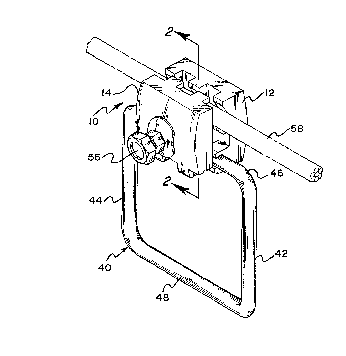Some of the information on this Web page has been provided by external sources. The Government of Canada is not responsible for the accuracy, reliability or currency of the information supplied by external sources. Users wishing to rely upon this information should consult directly with the source of the information. Content provided by external sources is not subject to official languages, privacy and accessibility requirements.
Any discrepancies in the text and image of the Claims and Abstract are due to differing posting times. Text of the Claims and Abstract are posted:
| (12) Patent: | (11) CA 2189578 |
|---|---|
| (54) English Title: | HINGED ELECTRICAL CONNECTOR |
| (54) French Title: | CONNECTEUR ELECTRIQUE A ARTICULATION |
| Status: | Expired and beyond the Period of Reversal |
| (51) International Patent Classification (IPC): |
|
|---|---|
| (72) Inventors : |
|
| (73) Owners : |
|
| (71) Applicants : |
|
| (74) Agent: | BORDEN LADNER GERVAIS LLP |
| (74) Associate agent: | |
| (45) Issued: | 2000-07-18 |
| (22) Filed Date: | 1996-11-04 |
| (41) Open to Public Inspection: | 1997-05-21 |
| Examination requested: | 1996-11-04 |
| Availability of licence: | N/A |
| Dedicated to the Public: | N/A |
| (25) Language of filing: | English |
| Patent Cooperation Treaty (PCT): | No |
|---|
| (30) Application Priority Data: | ||||||
|---|---|---|---|---|---|---|
|
An electrical connector includes a first jaw member that has an inside surface, an outside surface, a first end and a second end. The first jaw member further has a curved portion formed on the inside surface adjacent the first end. A second jaw member has an inside surface, an outside surface, a first end and a second end. The second jaw member also has a curved portion formed on the inside surface adjacent the first end. A terminal in the form of a stirrup is secured between the second ends of the first and second jaw members. The stirrup has a gap formed therethrough. Projecting from the second end of the first jaw member is a stop member. The stop member is positioned between the gap in the stirrup in order to prevent axial movement of the same along the electrical connector.
Un connecteur électrique comprend un premier élément de mâchoire possédant une surface interne, une surface externe, un premier et un deuxième bout. Le premier élément de mâchoire possède une portion courbe formée sur la surface interne adjacente au premier bout. Un deuxième élément de mâchoire possède une surface interne, une surface externe, un premier et un deuxième bout. Le deuxième élément de mâchoire possède une portion courbe formée sur la surface interne adjacente au premier bout. Une borne se présentant sous forme d'un étrier est fixée entre les deuxièmes bouts des premier et deuxième éléments de mâchoire. L'étrier présente un écart qui le traverse. Un élément de butée fait saillie du deuxième bout du premier élément de mâchoire. L'élément de butée est positionné dans l'écart de l'étrier afin d'empêcher tout déplacement axial de ce dernier le long du connecteur électrique.
Note: Claims are shown in the official language in which they were submitted.
Note: Descriptions are shown in the official language in which they were submitted.

2024-08-01:As part of the Next Generation Patents (NGP) transition, the Canadian Patents Database (CPD) now contains a more detailed Event History, which replicates the Event Log of our new back-office solution.
Please note that "Inactive:" events refers to events no longer in use in our new back-office solution.
For a clearer understanding of the status of the application/patent presented on this page, the site Disclaimer , as well as the definitions for Patent , Event History , Maintenance Fee and Payment History should be consulted.
| Description | Date |
|---|---|
| Time Limit for Reversal Expired | 2016-11-04 |
| Letter Sent | 2015-11-04 |
| Inactive: IPC from MCD | 2006-03-12 |
| Grant by Issuance | 2000-07-18 |
| Inactive: Cover page published | 2000-07-17 |
| Small Entity Declaration Determined Compliant | 2000-04-12 |
| Pre-grant | 2000-04-12 |
| Inactive: Final fee received | 2000-04-12 |
| Letter Sent | 1999-10-20 |
| Notice of Allowance is Issued | 1999-10-20 |
| Notice of Allowance is Issued | 1999-10-20 |
| Inactive: Approved for allowance (AFA) | 1999-09-29 |
| Inactive: Status info is complete as of Log entry date | 1998-04-21 |
| Inactive: Application prosecuted on TS as of Log entry date | 1998-04-21 |
| Application Published (Open to Public Inspection) | 1997-05-21 |
| All Requirements for Examination Determined Compliant | 1996-11-04 |
| Request for Examination Requirements Determined Compliant | 1996-11-04 |
There is no abandonment history.
The last payment was received on 1999-10-07
Note : If the full payment has not been received on or before the date indicated, a further fee may be required which may be one of the following
Patent fees are adjusted on the 1st of January every year. The amounts above are the current amounts if received by December 31 of the current year.
Please refer to the CIPO
Patent Fees
web page to see all current fee amounts.
Note: Records showing the ownership history in alphabetical order.
| Current Owners on Record |
|---|
| THOMAS P. POLIDORI |
| Past Owners on Record |
|---|
| MARIO POLIDORI |